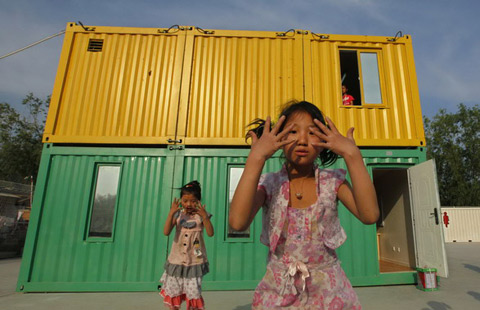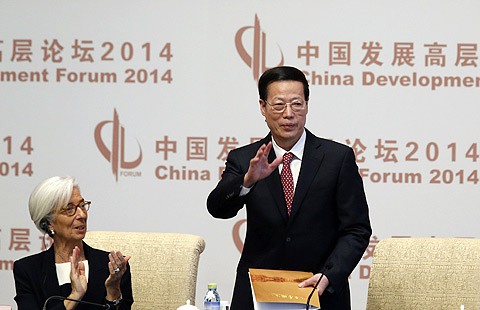Reduce inequality to sustain economic growth
Updated: 2014-03-31 10:32
By Vinod Thomas (China Daily)
|
|||||||||||
Three decades of high economic growth in China have served to lift millions of people out of poverty. But, at the same time, the gap between the rich and the poor has widened sharply, threatening welfare, social stability, and growth itself. Tackling inequality, therefore, is rightly at the top of the country's policy agenda.
A natural policy response to the emerging inequality is to try to include all the people in the economic agenda, which, in turn, would expand the possibilities for growth. This greater inclusion would also strengthen the impact growth has on reducing poverty. In China, improving the relative standing of the poor, who need to boost basic consumption, would also aid the government's objective of increasing domestic demand.
An indication of such inclusion is provided by a measure of income distribution. While income in Asia has historically been relatively egalitarian, it has grown increasingly unequal over the last two decades. The Gini coefficient for developing Asia increased from 39 in the mid-1990s to 46 in the late 2000s (zero represents complete equality and 100 complete inequality). In China, the Gini rose from below 30 in the 1970s to over 47 in recent years.
China must also grapple with the great income divide separating richer urban areas from the rural. Income levels are also substantially higher in the eastern coastal regions compared with the western parts. Cost of living is typically lower in the rural and poorer areas but, even accounting for it, the real gaps are vast.
Inequality is partly rooted in economic globalization, over which an individual country has little control. For example, in the global setting we see rising returns on capital and an increasing premium paid for higher skills for some people, even in countries where low-skilled labor is abundant. Also, technological change has created winner-take-all contests for incomes. Reflecting these trends, the return on capital relative to labor in manufacturing output is estimated to have risen notably between the mid-1990s and the mid-2000s in China and India.
Meanwhile, countries can control other sources of inequality. One issue relates to disparities in education. In some Asian countries, school-age children from households in the poorest income quintile are three to five times more likely to be out of primary and secondary school as those in the richest quintile. Actions to improve access for the poor to education will help. Efforts also need to focus on improving quality and ensuring through education that labor-force skills are a better match for labor market needs.
Yet, government spending on education and health as a share of gross domestic product in Asia is generally lower than comparable regions, and relatively low in China compared with other upper-middle-income countries. Governments, by increasing spending on education, health, social protection and better pension schemes, could free funds among poorer households for greater consumption.
Another area ripe for improvement involves sectors with high labor intensity, such as agriculture. We have seen a secular decline in agricultural investments and productivity in most regions of the world, the negative impact of which was heightened in recent years with the rise in food prices. Countries and international financial institutions recognize the decline in agricultural investments that this has helped bring about should be reversed.
Improving agricultural productivity and efficiency cannot only help the rural poor by increasing their incomes, but also the urban poor by lowering food prices. The urban share of the population in China has surged, from less than 35 percent in 2000 to 50 percent in 2010. Greater attention to agriculture and rural development can improve the quality of urbanization.
Yet another consideration is that the State needs to deliver services better. China, India, Indonesia and the Philippines are working to improve organizational structures to provide better social services, while combating corruption. In doing so, they also need to ensure that they match the current trend for decentralization of public service provision with adequate fiscal resources, including for transfers to lower-level governments. In China, governments below the provincial level now account for more than half of public expenditure. Decentralization has left many poor villages unable to afford them.
Finally, governments need to boost fiscal space to promote greater inclusion, which would involve measures that expand the tax base, boost the formal sector of the economy, improve tax administration and curtail tax evasion.
The author is director-general, independent evaluation at the Asian Development Bank in Manila. The views do not necessarily reflect those of China Daily.
|
 |
 |
Related Stories
Questioning sustainability of China economic growth 2014-03-24 07:34
Green outlook trumps economic growth in Tibet 2014-03-11 07:28
Focus still on economic growth 2014-03-08 08:40
Chinese premier stresses stable economic growth 2014-03-05 11:53
Supporting China's economic growth 2014-02-21 09:18
China confident in meeting economic growth target 2014-01-23 09:29
Today's Top News
Partnership with Belgium, EU highlighted
Turkish PM wins local elections
Monday's search for MH 370 resumes: AMSA
Families of flight MH370 passengers 'need closure'
Greece passes new reform bill
Dobass demonstrators demand referendum
MH370 relatives demand answers
Turkey starts local elections
Hot Topics
Lunar probe , China growth forecasts, Emission rules get tougher, China seen through 'colored lens', International board,
Editor's Picks

|

|

|

|

|

|





